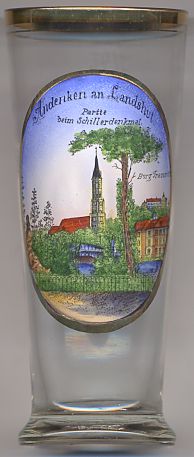

|
| DEUTSCHLAND | GERMANY |
| Bundesland: Freistaat Bayern | Bavaria |
| Regierungsbezirk: Niederbayern | |
| Stadt: Landshut |
Landshut is situated at an elevation of 477 m on the Isar river. Landshut is the capital of the administrative region Niederbayern (Lower Bavaria) and has a population of about 60,800 (2005).
The city of Landshut and Trausnitz castle were founded in 1204 by Duke Ludwig I. Already in 1231 Landshut became
a Wittelsbach residence and in 1255 when the duchy of Bavaria was split in two Landshut became also the capital of
Lower Bavaria. Duke Heinrich XVI was the first of the three famous 'rich dukes', who reigned Bayern-Landshut in
the 15th century. The wedding of Duke Georg with the Polish princess royal Jadwiga Jagiellon in 1475 was celebrated in
Landshut with one of the most splendid festivals of the Middle Age (today remembered as the "Landshuter Hochzeit").
After his death and a short war of succession Lower Bavaria (Bayern-Landshut) was reunited with Upper Bavaria
(Bayern-Munich). Ludwig X, Duke of Bavaria, built the Landshut Residence in 1537–1543
after his visit in Italy. He bulit the first Renaissance palace constructed north of the Alps after the Palazzo Te
in Mantua. Duke Wilhelm V ordered to upgrade Trausnitz Castle from a Gothic fortification into a Renaissance complex
when he lived in Landshut as crown prince for ten years until 1579. Afterwards, Landshut lost most of its importance until
the university of Ingolstadt was moved to Landshut in 1800. But already in 1826 the university was transferred to Munich.
Since the opening of the Munich airport close to Landshut in 1992 the city has become an attractive business location.
[Text adapted from en.wikipedia.org/wiki/Landshut]

One of the landmarks of Landshut is the
(see also list of other basilicae minores depicted on glasses of this collection)
The  collegiate
collegiate Trausnitz castle [background right] was founded in 1204 by Duke Ludwig I of Bavaria.
It is only since the 16th century that it has been called "Trausnitz". Before this time it carried the same name as the town.
The name Landshut literally means 'hat of the land'. And the castle plays the part of the 'hat# providing protection for the
city and the surrounding land. The castle was the home of the Wittelsbach dynasty, serving as their residence as dukes of
Lower Bavaria from 1255–1503, and later as hereditary rulers of the whole of Bavaria. Duke Friedrich I of Habsburg
(Friedrich 'the Fair'; Friedrich III as King of the Romans) was confined here from 1322 to 1325 after his capture by
Emperor Ludwig IV ('the Bavarian'). Due to the wealthy dukes of Bavaria-Landshut, Trausnitz castle underwent many renovations and
expansions of its buildings in the 15th and 16th century. In 18th century, however, the castle was used as a barracks and a prison
for noble prisoners. In the beginning of the 19th century it was used as a hospital. Several rooms were adapted for
King Ludwig II of Bavaria in 1869–1873. On 21 October 1961, most parts of the castle were destroyde by fire.
Among the parts that have survived were the 'Jester's Staircase' ('Narrentreppe') of 1578 and the late Romanesque
chapel of St. George of the early 13th century. Other parts of the castle were reconstructed.
[Text adapted from http://en.wikipedia.org/wiki/Trausnitz_Castle,
https://de.wikipedia.org/wiki/Burg_Trausnitz]
Trausnitz castle [background right] was founded in 1204 by Duke Ludwig I of Bavaria.
It is only since the 16th century that it has been called "Trausnitz". Before this time it carried the same name as the town.
The name Landshut literally means 'hat of the land'. And the castle plays the part of the 'hat# providing protection for the
city and the surrounding land. The castle was the home of the Wittelsbach dynasty, serving as their residence as dukes of
Lower Bavaria from 1255–1503, and later as hereditary rulers of the whole of Bavaria. Duke Friedrich I of Habsburg
(Friedrich 'the Fair'; Friedrich III as King of the Romans) was confined here from 1322 to 1325 after his capture by
Emperor Ludwig IV ('the Bavarian'). Due to the wealthy dukes of Bavaria-Landshut, Trausnitz castle underwent many renovations and
expansions of its buildings in the 15th and 16th century. In 18th century, however, the castle was used as a barracks and a prison
for noble prisoners. In the beginning of the 19th century it was used as a hospital. Several rooms were adapted for
King Ludwig II of Bavaria in 1869–1873. On 21 October 1961, most parts of the castle were destroyde by fire.
Among the parts that have survived were the 'Jester's Staircase' ('Narrentreppe') of 1578 and the late Romanesque
chapel of St. George of the early 13th century. Other parts of the castle were reconstructed.
[Text adapted from http://en.wikipedia.org/wiki/Trausnitz_Castle,
https://de.wikipedia.org/wiki/Burg_Trausnitz]
 monument for Friedrich Schiller [extreme left]
was created by the sculptor Sebastian Osterrieder (1864–1932).
monument for Friedrich Schiller [extreme left]
was created by the sculptor Sebastian Osterrieder (1864–1932).
[http://regiowiki.pnp.de/index.php/Sebastian_Osterrieder]
![[scale]](lineal.jpg)